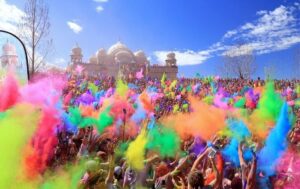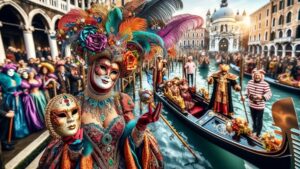Cultural festivals are more than just a celebration; they are a vivid expression of a community’s heritage, traditions, and identity. They offer a unique window into the soul of a place, providing travelers with an immersive experience that goes beyond the usual tourist attractions. Whether you’re a seasoned traveler or someone looking to explore the world through its rich tapestry of customs, these must-visit cultural festivals promise to be unforgettable experiences.
1. Rio Carnival, Brazil

- When: February/March (before Lent)
- Where: Rio de Janeiro, Brazil
- Reasons to Go: The Rio Carnival is the biggest and most well-known carnival worldwide. Millions of people travel from all over the world to attend this festival, which is well-known for its colorful parades, samba dancers, and spectacular costumes. The Sambadrome, where samba schools compete in a stunning exhibition of song, dance, and color, is the focal point of the festival. The carnival is a celebration of life, joy, and Brazilian culture, and its contagious spirit is contagious.
2. Diwali, India

- When: October/November (dates vary according to the lunar calendar)
- Where: Across India
- Reasons to Go: One of the biggest Hindu holidays, Diwali, also known as the Festival of Lights, is widely observed throughout India. The celebration represents the triumph of good over evil and light over darkness. A mystical ambiance is created by lighting up homes and cities with oil lamps, candles, and fireworks. Thousands of lamps illuminate the ghats along the Ganges River in cities like Varanasi, creating an amazing scene. Diwali is a delightful occasion that is enhanced by family get-togethers, feasts, and the sharing of sweets.
3. Oktoberfest, Germany

- When: Late September to the first weekend in October
- Where: Munich, Germany
- Reasons to Go: Oktoberfest, which draws more than six million visitors annually, is the biggest beer festival in the world. With authentic music, dancing, and delicious German food, it’s a celebration of Bavarian culture. Large beer tents at the event are a well-known feature, wherein nearby breweries serve one-liter steins of specially prepared Oktoberfest beer. Oktoberfest is more than just beer; it’s also about vibrant parades, traditional costumes, and the spirit of friendship that unites people from all over the world.
4. Chinese New Year, China

- When: January/February (dates vary according to the lunar calendar)
- Where: Across China, with major celebrations in Beijing, Shanghai, and Hong Kong
- Reasons to Go: The Spring Festival, or Chinese New Year, is China’s most significant traditional celebration. Beginning with a reunion supper on New Year’s Eve and concluding with the Lantern Festival, the festivities last fifteen days. Fireworks light up the sky, dragon dances are performed, and streets are decked with red lanterns. You may take in the splendor of temple fairs, which feature traditional performances, handicrafts, and cuisine on exhibit, in places like Beijing and Shanghai. The event provides an in-depth look into Chinese culture and is a time for family, rejuvenation, and paying tribute to ancestors.
5. Holi, India

- When: March (dates vary according to the lunar calendar)
- Where: Across India, with major celebrations in Mathura and Vrindavan
- Reasons to Go: One of the world’s most colorful and joyful celebrations is Holi, also known as the Festival of Colors. Holi is a springtime festival that is marked by the colorful, rainbow-colored spectacle of powdered colors being tossed around. In addition, singing, dancing, and sweets sharing are all part of the celebration. The celebrations are especially vibrant and attract sizable crowds in the Hindu towns of Mathura and Vrindavan, which are connected to the god Krishna. Holi is a must-attend event because it is a celebration of joy, love, and the victory of good over evil.
6. Day of the Dead, Mexico

- When: November 1-2
- Where: Across Mexico, with major celebrations in Mexico City, Oaxaca, and Mixquic
- Reasons to Go: The profound and unique celebration of life and death is known as Día de los Muertos, or Day of the Dead. This event, in contrast to conventional views of death, is about celebrating and remembering departed loved ones in a happy and positive way. Families construct altars, or ofrendas, and decorate them with mementos, candles, marigolds, and the deceased’s favorite delicacies. The streets of cities such as Oaxaca come alive with traditional music, parades, and individuals costumed in elaborate costumes as skeletons, known as calacas. A striking reminder of both the cyclical nature of life and the enduring links of love is provided by the festival.
7. Edinburgh Festival Fringe, Scotland

- When: August
- Where: Edinburgh, Scotland
- Reasons to Go: The largest arts festival in the world, the Edinburgh Festival Fringe, features thousands of acts in a variety of genres, such as comedy, dance, drama, and music. Originating in 1947 as a substitute for the Edinburgh International Festival, it has expanded into an international cultural event. Edinburgh transforms into a bustling stage where performers from all over the world take the stage in both conventional and non-traditional settings. Because of the festival’s open-access philosophy, anybody with a performance to offer or a story to tell is welcome to take part, making it a truly inclusive and diverse celebration of creativity.
8. Venice Carnival, Italy

- When: February (before Lent)
- Where: Venice, Italy
- Reasons to Go: The Venice Carnival, renowned for its spectacular masks and costumes, is a mystical celebration of art, history, and tradition. When the celebration first began in the twelfth century, people from different social groups were able to mingle openly while donning masks. Grand balls, masked parades and theatrical productions are all part of the funfair today, which takes place in Venice’s ancient palaces and squares. Together with the mystique and grace of the costumes, the city’s distinctive architecture creates a magical ambiance that carries tourists back in time.
9. Gion Matsuri, Japan

- When: July
- Where: Kyoto, Japan
- Reasons to Go: One of Japan’s most well-known festivals, Gion Matsuri has been celebrated for more than a millennium. The event, which takes its name from Kyoto’s Gion neighbourhood, is celebrated to please the gods during periods of natural disasters and plague. The festival’s centerpiece is the magnificent parade of floats, or yamaboko, which are exquisitely adorned with tapestries, lanterns, and handcrafted items. The Yasaka Shrine will host a number of religious ceremonies, street food vendors, and traditional music throughout the festival. Gion Matsuri is a colorful celebration of Kyoto’s rich cultural past that offers an insight into prehistoric Japanese customs.
10. La Tomatina, Spain

- When: The last Wednesday of August every year
- Where: Buñol, a small town near Valencia, Spain
- Reasons to Go: One of the strangest and most vibrant events in the world, La Tomatina is well-known for its enormous tomato war. Overripe tomatoes are thrown at one another in this happy, chaotic festival, which turns the streets into a red, mushy battlefield. People from all over the world gather to celebrate this special custom, and the festival is all about having a good time and bonding with one another. For La Tomatina, people go from all around to Buñol just to feel the excitement of taking part in such a big, fun event. Not only is there a tomato fight, but the festival is a week-long celebration of Spanish hospitality and culture that includes parades, dancing, and music.
These cultural festivals are immersive experiences that let visitors get in touch with a location’s spirit and heart; they are more than just events. These festivals provide a unique opportunity to learn about the globe and its many cultures, whether you’re drawn to the vivid colors of Holi, the age-old customs of Gion Matsuri, or the exuberant atmosphere of Oktoberfest. So prepare to travel the world through its most treasured festivals and pack your baggage.
Happy Travels!
